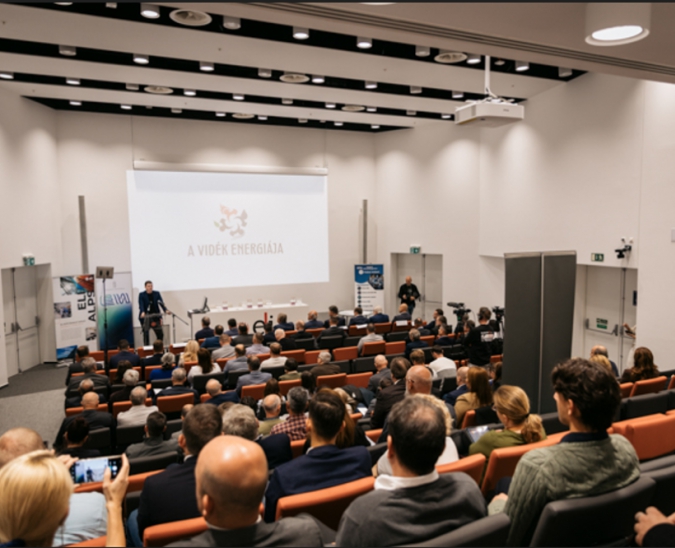
The "Energy of the Countryside" conference was opened by Prof. Dr. László Rovó, Rector of the University of Szeged (SZTE), welcomed by Béla Mihálffy, Member of Parliament, and the thematic outline was presented by Gábor Riz, Member of Parliament, Ministerial Commissioner, and Chairman of the Energy Sub-Committee of the Parliamentary Economic Committee.
During the event, Gábor Czepek, Deputy Minister and Parliamentary State Secretary of the Ministry of Energy, detailed the Hungarian government's stance. He stressed that domestic energy security requires base-load power plants, and integrating renewable energy generation necessitates building balancing capacity to store solar and wind power for domestic evening needs. According to the State Secretary, nuclear energy and renewables are the alternatives for electrification and reducing carbon dioxide emissions in Hungary today. The country's solar power plant capacity has grown from an initial 10 megawatts (MW) to 8,000 MW. To increase the balancing capacity needed for renewable energy generation, the MVM Group plans to commission a 1,500 MW capacity Combined Cycle Gas Turbine (CCGT) technology in 2027. Gábor Czepek projects that Hungary's solar power capacity will reach 12 gigawatts (GW) by 2030, with a corresponding storage capacity target of 30–35 percent.
Viktor Horváth, Deputy State Secretary of the Ministry of Energy, presented the local energy generation and optimisation solutions of the Jedlik Ányos Programme, while Gábor Bányai, Government Commissioner, highlighted the exploitation of geothermal energy as a major energy opportunity for rural areas.
The Significance of Active Participation
While the forum was made successful by numerous organizers (such as the Ministry of Energy, the Energy Strategy Institute, the University of Szeged, and the Hungarian Renewable Energy Association) and valuable speakers, the significance of the Archenerg-Metal Cluster lay in its members establishing strategic connections on site. Through targeted networking and personal discussions, the Cluster further strengthened its role in finding solutions for the future of rural energy management.
The forum focused on key issues such as:
- establishing local supply security,
- optimising available energy sources,
- the role of energy storage technologies and local solutions (e.g., geothermal energy, solar energy utilisation).
These topics are closely aligned with the Cluster's objectives, which aim to promote renewable energy sources, energy efficiency, and green technologies. The fresh, firsthand information gained on site and the directly established fruitful relationships (including those with strategic partner SZTE) will directly assist Cluster members in generating future projects, securing financing, and implementing technological developments.
Forum Messages and Cluster Synergy
The forum highlighted current challenges and innovative responses in the energy sector, especially in the Southern Great Plain region, a key area for the Cluster. Two notable presentations showcased the excellent solutions of SZTE, offering direct synergy with the interests of Cluster members:
- Circular Economy and Innovative Energy Storage: Prof. Dr. Csaba Janáky (SZTE IKIKK Greennovation Center) emphasized the importance of green hydrogen, synthetic fuel production, and storage capacities. As the Cluster's scope includes establishing a renewable energy incubator centre and developing energy storage solutions, this area provides an excellent basis for building new industrial partnerships and launching joint R&D projects.
- Energy Efficiency and Geothermal Energy: Ferenc Csóti (Technical Director of SZTE) presented the university's successes, highlighting the utilisation of geothermal energy, which replaced over 1 million cubic meters of natural gas. The Archenerg-Metal Cluster is also active in geothermal energy utilisation (design and execution of heat pump systems), providing an opportunity on site to adopt best practices and discuss potential collaborations.
The Future: Value Creation through Connections
For the Archenerg-Metal Cluster, active participation in the "Energy of the Countryside" professional forum represented not just a presence, but a strategic investment in the future. The outlined directions—the combined use of nuclear and renewables, the development of storage capacities (e.g., MVM's planned 1,500 MW CCGT technology), and the opportunities for local energy communities—are all areas where Cluster members can actively contribute to achieving national energy goals with their expertise and technological solutions.
The connections established and the information gathered at the forum will help the Cluster more effectively support the creation of an economic and social model based on renewable energy sources and energy awareness, and prepare its members for the key chemical industry process of the 21st century: the circular carbon dioxide economy.
